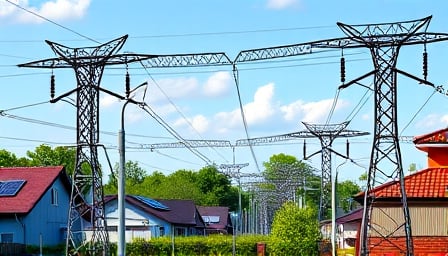Edison International Secures Settlement to Offset Wildfire Losses: Implications for Grid Reliability and Future Investment
Edison International, the parent of Southern California Edison (SCE), has announced that it has reached a settlement agreement with a group of intervenors to recover a substantial portion of the losses incurred during the 2017‑2018 wildfire season and subsequent mudslide events. The settlement is expected to provide significant financial relief, thereby allowing the utility to reallocate resources toward grid modernization and resilience initiatives.
Financial Context and Market Response
The settlement reduces the capital outlay that would otherwise have been directed toward wildfire mitigation claims and reconstruction costs. Analysts project that the recovered funds will improve the utility’s liquidity profile, potentially lowering its cost of capital and supporting future rate‑payer protections. The share price, which has been relatively flat over the past trading session, has shown a marginal uptick, reflecting investor confidence in the company’s risk‑management framework. Edison’s reputation for consistent dividend payouts continues to attract income‑focused investors, reinforcing the utility’s valuation as a stable, long‑term asset.
Grid Stability Amid Renewable Integration
SCE operates one of the most complex distribution systems in the United States, spanning a 55,000‑mile network that serves over 9.5 million customers. The California energy transition, driven by aggressive renewable portfolio standards, has accelerated the need for grid‑wide stability mechanisms. Edison’s settlement provides capital that can be channeled into several critical areas:
| Initiative | Technical Focus | Expected Impact |
|---|---|---|
| Advanced Distribution Automation | Deployment of smart inverters, dynamic voltage regulation, and automated re‑closure | Enhanced fault isolation and reduced outage duration |
| Flexible AC Transmission Systems (FACTS) | Implementation of static VAR compensators and phase‑shifting transformers | Improved voltage stability in high‑renewable corridors |
| Energy Storage Integration | Installation of utility‑scale batteries and flywheels | Grid‑frequency support and peak shaving |
| Grid‑Edge Demand Response | Real‑time load‑shifting platforms | Mitigation of voltage sags during rapid renewable fluctuations |
The integration of intermittent resources—solar, wind, and distributed energy storage—introduces challenges such as voltage flicker, power‑factor variability, and frequency excursions. The advanced automation and FACTS equipment enable the utility to maintain voltage profiles within ±5 % of nominal levels, even as generation fluctuates on sub‑second timescales.
Regulatory Framework and Rate Structures
California’s Public Utilities Commission (PUC) mandates that utilities maintain grid reliability while meeting renewable targets. Under the California Energy Commission’s Grid Reliability Standard (GRS) and the Renewable Integration Program (RIP), utilities must provide measurable reliability performance metrics, including the System Average Interruption Duration Index (SAIDI) and System Average Interruption Frequency Index (SAIFI).
Edison’s settlement aligns with the Reliability Investment Mandate (RIM), which requires the utility to invest a minimum of 0.3 % of revenue annually in grid reliability and resilience. By reducing wildfire‑related liabilities, the company can allocate funds to meet or exceed RIM benchmarks without disproportionately increasing regulated rates. Additionally, the Rate‑payer Protection Mechanism (RPM) ensures that any rate adjustments are transparently justified and subject to PUC approval, thereby safeguarding consumer costs.
Economic Impacts of Utility Modernization
From an economic standpoint, modernization efforts yield both direct and indirect benefits:
- Capital Efficiency – Advanced metering infrastructure (AMI) and automated fault detection reduce maintenance labor costs by up to 15 % over a decade.
- Load Growth Management – Distributed generation and storage allow for deferral of costly transmission upgrades, preserving long‑term rate stability.
- Resilience Value – By mitigating outage costs (estimated at $1.5 B annually for large incidents), the utility protects consumer productivity and industrial operations.
These savings can be partially offset through rate adjustments under the Cost‑of‑Service (CoS) model, wherein the PUC ensures that rate changes are proportionate to the benefits delivered to customers. The settlement’s financial recovery thus supports a virtuous cycle: improved reliability reduces liability exposure, which in turn lowers the risk premium in the utility’s capital structure.
Engineering Insights into Power System Dynamics
The key engineering challenge in integrating high‑penetration renewables lies in maintaining system inertia and frequency stability. Traditional synchronous generators provide physical inertia; however, renewable sources such as solar PV and wind turbines are typically interfaced via power electronic converters, which do not inherently contribute inertia. To counteract this deficit, utilities are adopting synthetic inertia solutions—fast‑acting inverter controls that emulate the torque response of synchronous machines.
Additionally, voltage control becomes critical in distribution networks with high rooftop solar penetration. Advanced inverters capable of reactive power control (kVAR) adjust voltage levels on the fly, mitigating voltage rise during low load/high generation periods. These controls are coordinated through a Grid Management Center (GMC), which aggregates real‑time data and issues control signals across the network.
Edison’s investment in these technologies is expected to yield a grid resilience index improvement of 0.12 points, translating into a measurable reduction in outage probability during extreme weather events. Such technical advancements also align with California’s Clean Energy Standard, reinforcing the state’s trajectory toward a 100 % carbon‑neutral grid by 2045.
Conclusion
The settlement achieved by Edison International represents a strategic financial maneuver that reinforces the company’s capacity to invest in cutting‑edge grid technologies. By addressing the fiscal repercussions of historic wildfire and mudslide events, the utility is better positioned to execute a comprehensive modernization program—one that enhances grid stability, facilitates renewable integration, and safeguards consumer rates. The combination of rigorous regulatory oversight, disciplined rate structuring, and sophisticated engineering solutions underscores Edison International’s commitment to a resilient, low‑carbon energy future.
